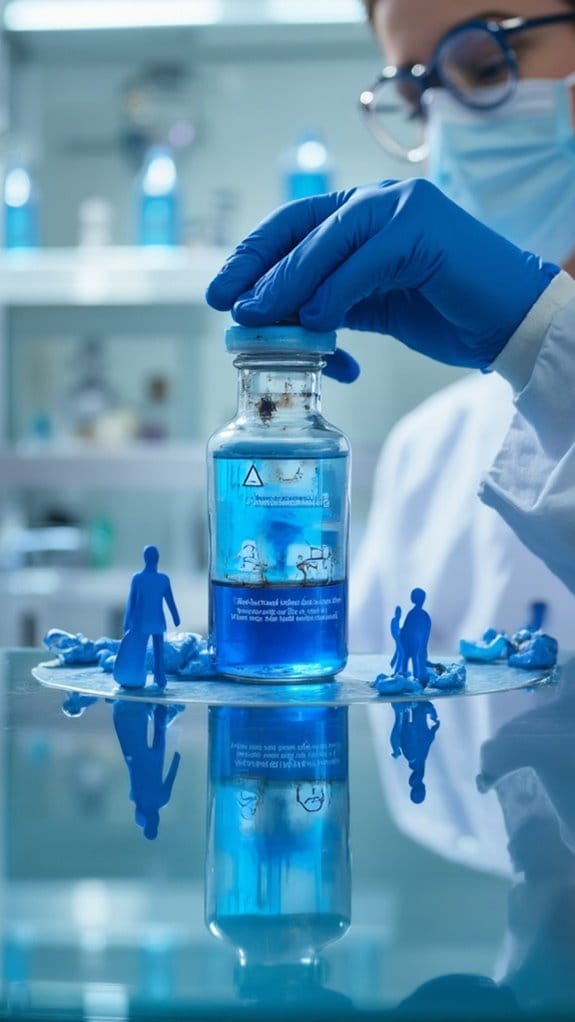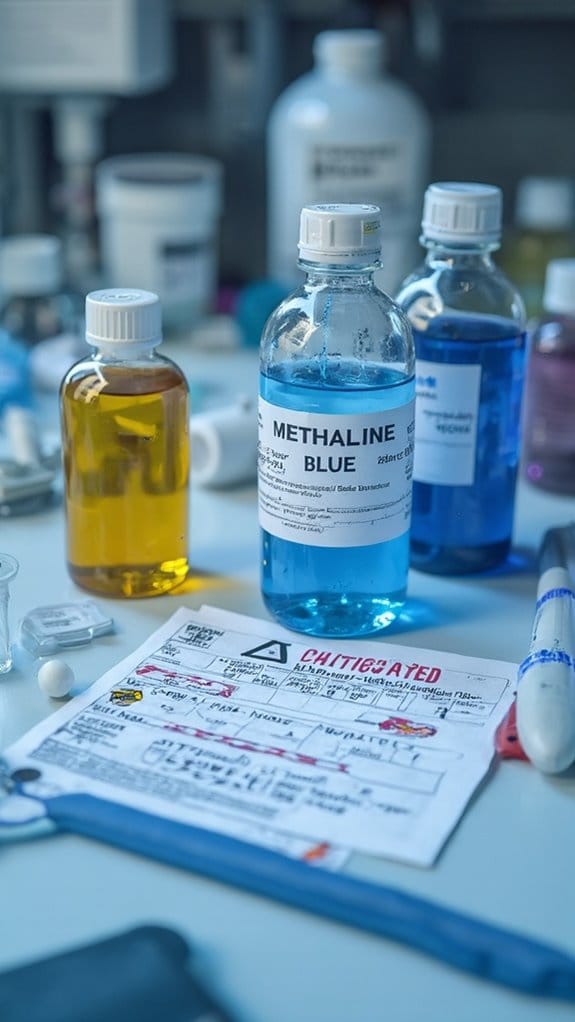When it comes to using methylene blue, you need to be aware of its benefits and risks. While it can enhance cellular respiration and help treat certain conditions, it also has potential side effects like nausea and confusion. Some folks should avoid it altogether, particularly those with G6PD deficiency or on specific medications. Proper handling and storage are essential for safety. Curious about the best practices to guarantee safe use and to stay informed? There’s more ahead!
Key Takeaways
- Methylene blue should be avoided by pregnant or breastfeeding individuals and those with G6PD deficiency due to hemolytic anemia risks.
- Monitor for adverse effects like nausea, dizziness, and allergic reactions, and report any unusual symptoms to healthcare providers.
- Consult healthcare professionals before use, especially if taking antidepressants or blood thinners, to prevent dangerous drug interactions.
- Store methylene blue in a cool, dark place, using opaque containers to prevent degradation and protect from moisture.
- Dispose of waste properly by following local hazardous waste regulations and keeping records of disposal for compliance.
Understanding Methylene Blue: Overview and Uses

Methylene blue might sound like a complex chemical name, but it’s got a fascinating story and a variety of uses that you might not expect. Originally synthesized in 1876, its vibrant blue color quickly caught the attention of scientists and artists alike.
You might be surprised to know that methylene blue's chemical properties make it a powerful dye and an effective redox indicator. It’s used in everything from biology labs to textile production, showcasing its versatility.
But it doesn’t stop there! Methylene blue's history is filled with exciting twists, as it has been explored for its potential in various fields, including medicine.
Therapeutic Benefits of Methylene Blue

While you might think of methylene blue purely as a dye, it boasts some intriguing therapeutic benefits that are gaining attention in the medical field. You might be surprised to learn that this compound has therapeutic mechanisms that could help in treating certain conditions.
For instance, its ability to enhance cellular respiration has led to clinical applications in areas like neuroprotection and even treating methemoglobinemia. Imagine a small blue pill that could potentially support brain health or improve oxygen delivery in your blood!
Moreover, researchers are exploring its role in combating infections and as an adjunct in cancer therapies. Isn’t it fascinating how something so simple can have such profound effects?
Researchers are investigating methylene blue's potential in fighting infections and enhancing cancer treatments—remarkable for such a simple compound!
Of course, like anything, it’s essential to understand its limitations and risks. So, if you’re intrigued, it’s worth diving deeper into the world of methylene blue and its therapeutic potential!
Common Side Effects and Adverse Reactions

When exploring the potential of methylene blue, it’s important to contemplate the flip side: its common side effects and adverse reactions. While many people seek its therapeutic benefits, it’s essential to be aware of methylene blue toxicity, which can result in nausea, dizziness, or even confusion. Imagine feeling lightheaded when you just want clarity!
Additionally, allergic reactions can occur, ranging from rashes to more severe responses. It’s critical to pay attention to your body’s signals. Are you feeling off after taking it? Don’t ignore that!
Contraindications: Who Should Avoid Methylene Blue?

Before you consider incorporating methylene blue into your routine, it’s important to know who should steer clear of it altogether. There are certain methylene blue contraindications that you shouldn’t ignore.
If you’re pregnant or breastfeeding, it’s best to pass on this compound. Additionally, individuals with G6PD deficiency should avoid it, as it can trigger hemolytic anemia, a serious condition.
High-risk populations, including those with severe renal impairment or certain types of depression, should also think twice before using methylene blue. Why take unnecessary risks when there are alternatives available? It’s essential to listen to your body and prioritize your health. If you fall into one of these categories, consult a healthcare professional to explore safer options.
After all, freedom in your health choices means making informed decisions that keep you thriving!
Drug Interactions: What You Need to Know

Maneuvering the world of medications can feel like walking through a minefield, especially when it comes to drug interactions.
When you're managing your health, understanding how methylene blue interacts with other medications is essential for drug safety.
Here's what you need to keep in mind:
Always consult your healthcare provider about any medications you're taking to avoid unexpected interactions.
- Antidepressants: Methylene blue can interact dangerously with certain antidepressants, potentially leading to serotonin syndrome.
- Blood thinners: Combining methylene blue with anticoagulants may heighten bleeding risks.
- Monoamine oxidase inhibitors (MAOIs): These should be avoided altogether, as the combination can have severe side effects.
- Other medications: Always consult with your healthcare provider about any other drugs you're taking to avoid unexpected reactions.
Safe Dosage Guidelines and Administration

When it comes to using methylene blue, knowing the right dosage is key to staying safe. So, what are the recommended ranges, and how do you administer it? Let’s break down the essentials to guarantee you get it right without any guesswork.
Recommended Dosage Ranges
Methylene blue can be a fascinating compound, but knowing the recommended dosage ranges is crucial for safety. You wouldn’t want to miss the right balance, right?
Here are some dosage guidelines to keep in mind:
- For adults: 1-2 mg/kg for specific conditions.
- For children: Generally, 0.5-1 mg/kg is recommended.
- For short-term use: Stick to lower doses to gauge your body’s response.
- Consult a healthcare professional: Always check before starting, especially if you’re on other medications.
Understanding these dosage guidelines guarantees you harness the benefits of methylene blue while minimizing risks. After all, freedom in health comes from making informed choices, doesn’t it? Stay safe and be smart about your health!
Administration Methods Overview
Understanding how to safely administer methylene blue is just as important as knowing the right dosage. You’ve got options!
Whether you choose intravenous administration, oral administration, topical application, or intramuscular injection, each method has its unique benefits. Intravenous administration offers rapid effects, while oral administration is often more convenient and less invasive.
Topical application is great for localized treatments, and intramuscular injections can provide a good middle ground. But remember, whatever method you opt for, it’s essential to adhere to safe dosage guidelines. After all, you want to harness the benefits without risking your health, right?
Best Practices for Handling Methylene Blue

When handling methylene blue, you’ve got to prioritize safety—trust me, you don’t want to end up with a colorful mishap! Wearing personal protective equipment, like gloves and goggles, is a must to keep yourself safe from any spills. Plus, knowing the proper disposal methods won't only protect you but also help keep the environment clean—who wouldn’t want that?
Personal Protective Equipment
Handling chemicals like Methylene Blue can seem intimidating, but wearing the right personal protective equipment (PPE) makes all the difference in guaranteeing your safety.
You want to feel free and secure while working, right? Here are four essential items you shouldn’t skip:
- Gloves: Guarantee proper glove usage to protect your hands from any spills or skin contact.
- Eye Protection: Safety goggles are a must to shield your eyes from splashes.
- Lab Coat: A lab coat keeps your clothes clean and adds an extra layer of protection.
- Respirator Mask: If you’re in a poorly ventilated area, a mask can help filter out harmful vapors.
Proper Disposal Methods
Once you’ve got your gloves and goggles on, it’s time to think about what to do with Methylene Blue after you’re done working with it. Proper disposal methods are essential for both your safety and the environment.
First, check local regulations—can you toss it in the trash or pour it down the drain? Often, that’s a no-go. Instead, you might need to collect it in a designated waste container, ensuring it’s clearly labeled. When it comes to waste management, consider contacting a local hazardous waste facility; they’ll know how to handle it safely.
Storage and Stability Considerations

Properly storing methylene blue is essential for maintaining its effectiveness, and you wouldn't want to end up with a compromised product, right?
Proper storage of methylene blue is crucial to ensure its potency and effectiveness. Don't risk a compromised product!
To guarantee its molecular stability, pay attention to these storage conditions:
- Keep it cool: Store methylene blue in a cool, dark place to prevent degradation.
- Avoid moisture: Seal the container tightly to protect it from humidity.
- Light matters: Use opaque containers to shield it from light, which can affect its potency.
- Check expiration: Regularly monitor the product's shelf life and dispose of any that’s past its prime.
Monitoring and Reporting Adverse Effects
When using methylene blue, it’s essential to keep an eye out for any adverse effects that might pop up. You want to be proactive, right? Adverse event tracking is vital for your safety and well-being. If you notice anything unusual, don’t hesitate to jot it down.
Patient reporting is key; your experiences can help others and contribute to a larger understanding of the treatment. Ever felt a bit off after taking a medication? Trust your instincts! Not only should you monitor your reactions, but you should also encourage those around you to do the same.
It’s all about creating a community where everyone can share their experiences.
Regulatory Status and Research Developments

Now that we’ve looked at monitoring and reporting adverse effects, let’s shift gears and chat about the regulatory status and research developments surrounding methylene blue. You might be wondering how this compound fits into the current guidelines and what recent studies are revealing about its safety and effectiveness.
Buckle up, because the journey through regulations and fresh findings could surprise you!
Current Regulatory Framework
As you immerse yourself in the world of Methylene Blue, it’s essential to understand the regulatory framework that surrounds it—after all, knowing the rules of the game can help you make informed decisions.
Here are some key points to reflect upon:
- Regulatory Compliance: Methylene Blue’s use is governed by agencies like the FDA, ensuring safety and efficacy.
- Safety Assessments: Regular evaluations are conducted to monitor any potential risks associated with Methylene Blue.
- Research Updates: Stay informed about ongoing studies that may influence regulations.
- User Awareness: It’s vital for you to know how regulations impact accessibility and usage.
Understanding these elements empowers you to navigate the landscape of Methylene Blue responsibly, allowing you to make choices that align with your health and freedom.
Recent Research Findings
While you’ve got a handle on the regulatory landscape for Methylene Blue, it’s equally important to stay updated on the latest research findings that shape its status. Recent studies have revealed intriguing insights into its safety evaluations, particularly regarding its potential therapeutic uses. Researchers are exploring Methylene Blue's effects beyond the traditional scope, igniting discussions about its role in neuroprotection and anti-aging.
Aren’t you curious about how these developments could impact your choices? As science progresses, the understanding of Methylene Blue continues to evolve, highlighting the importance of staying informed.
Frequently Asked Questions
Can Methylene Blue Be Used During Pregnancy or Breastfeeding?
When it comes to using methylene blue during pregnancy or breastfeeding, caution is key. You might wonder about the potential effects on your baby. While some studies suggest it could pose risks, especially in pregnancy, it’s essential to discuss this with your healthcare provider.
They’ll help you weigh the benefits against the risks and guide you on necessary precautions. After all, you want the best for your little one, right?
What Should I Do if I Miss a Dose of Methylene Blue?
Have you ever felt that sinking feeling when you realize you’ve missed a dosage? Don’t worry, it happens! If you miss a dose of methylene blue, take it as soon as you remember, unless it’s almost time for your next dose. In that case, skip the missed one—proper administration is key!
Keep your routine consistent, and you’ll be on your way to feeling your best in no time. Just remember, don’t double up!
Is Methylene Blue Safe for Children or the Elderly?
Wondering if methylene blue is safe for kids or the elderly? Well, it’s crucial to tread carefully! Children’s safety is a top priority, and elderly folks often have different health needs, so caution is key.
Always consult a healthcare provider before use. After all, nobody wants a surprise when it comes to health, right? Staying informed guarantees you make the best choices for those you care about, because peace of mind is priceless!
How Long Does Methylene Blue Stay in the Body?
Did you know that methylene blue can linger in your body for up to 24 hours? That’s right! When it comes to methylene blue metabolism, your body breaks it down, but it’s not an instant process. Drug elimination varies by person, influenced by factors like age and health.
Can I Consume Alcohol While Using Methylene Blue?
You might be wondering if you can enjoy a drink while using methylene blue. Well, it’s best to tread carefully! Alcohol can interact with methylene blue, leading to increased side effects. Do you really want to risk headaches or dizziness? It’s a good idea to consult your doctor before mixing the two.
After all, your health’s worth more than a night out, right?
Conclusion
In the world of healthcare, methylene blue can be a double-edged sword—like a bright beacon guiding us toward potential healing, but also a reminder of the risks lurking in the shadows. By understanding its benefits and respecting its dangers, you’re not just staying safe; you’re becoming a savvy user. So, the next time you encounter methylene blue, think of it as a vibrant thread in the intricate tapestry of medicine—powerful, but best handled with care.
